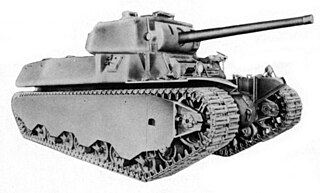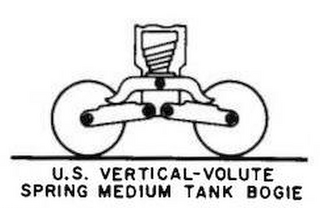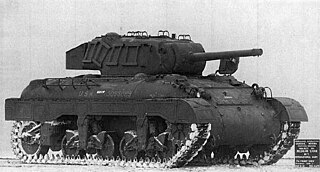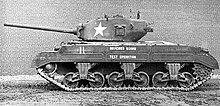
The M4 Sherman, officially Medium Tank, M4, was the most widely used medium tank by the United States and Western Allies in World War II. The M4 Sherman proved to be reliable, relatively cheap to produce, and available in great numbers. It was also the basis of several other armored fighting vehicles including self-propelled artillery, tank destroyers, and armored recovery vehicles. Tens of thousands were distributed through the Lend-Lease program to the British Commonwealth and Soviet Union. The tank was named by the British after the American Civil War General William Tecumseh Sherman.

The M26 Pershing is a heavy tank/medium tank formerly used by the United States Army. It was used in the last months of World War II during the Invasion of Germany and extensively during the Korean War. The tank was named after General of the Armies John J. Pershing, who led the American Expeditionary Force in Europe in World War I.

The M24 Chaffee was an American light tank used during the later part of World War II; it was also used in post–World War II conflicts including the Korean War, and by the French in the War in Algeria and the First Indochina War. In British service it was given the service name Chaffee after the United States Army General Adna R. Chaffee Jr., who helped develop the use of tanks in the United States armed forces. Although the M41 Walker Bulldog was developed as a replacement, M24s were not mostly removed from U.S. and NATO armies until the 1960s and remained in service with some Third World countries.

The M3 Lee, officially Medium Tank, M3, was an American medium tank used during World War II. The turret was produced in two forms, one for US needs and one modified to British requirements to place the radio next to the commander. In British Commonwealth service, the tank was called by two names: tanks employing US-pattern turrets were called "Lee", named after Confederate general Robert E. Lee, while those with British-pattern turrets were known as "Grant", named after Union general Ulysses S. Grant.

The M18 Hellcat is a tank destroyer used by the United States Army in World War II and the Korean War. Despite being equipped with the same main gun as some variants of the much larger Sherman tank, the M18 attained a much higher top speed of up to 55 mph (89 km/h) by keeping armor to a minimum, and using the innovative Torqmatic automatic transmission.

The 75 mm gun, models M2 to M6, was the standard American medium caliber gun fitted to mobile platforms during World War II. They were primarily mounted on tanks, such as the M3 Lee and M4 Sherman, but one variant was also used as an air-to-ground gun on the B-25 Mitchell medium bomber aircraft. There were five main variants used during the war: M2, M3, M4, M5 and M6.

The M4 Sherman tank was produced in several variants, a result of mass production spread across several manufacturers and several years. It was also the basis for a number of related vehicles and Shermans have been modified by several nations, ranging from upgrades to complete hull conversions for another task. Originally designed in 1941, M4 variants were still used by Israel during the 1967 and 1973 wars with its Arab neighbors.

Tanks were an important weapons system in World War II. Even though tanks in the inter-war years were the subject of widespread research, production was limited to relatively small numbers in a few countries. However, during World War II, most armies employed tanks, and production levels reached thousands each month. Tank usage, doctrine and production varied widely among the combatant nations. By war's end, a consensus was emerging regarding tank doctrine and design.

The Heavy Tank M6 was an American heavy tank designed during World War II. The tank was produced in small numbers and never saw combat.

The Sherman M-50 and the Sherman M-51, both often referred to abroad as the Super Sherman, were modified versions of the American M4 Sherman tank that served with the Israel Defense Forces from the mid-1950s to early 1980s. The M-51 was also referred to as the Isherman. However, the nicknames "Super Sherman" and "Isherman" were never officially used by the Israeli Defense Forces.

The M2 medium tank, officially Medium Tank, M2, was a United States Army medium tank that was first produced in 1939 by the Rock Island Arsenal, just prior to the commencement of the Second World War in Europe. Production was 18 M2 tanks, and 94 slightly improved M2A1 tanks, for a total of 112. Events in Western Europe rapidly demonstrated that the M2 was obsolete, and it was never used overseas in combat; it was, however, used for training purposes throughout the war.

This article deals with Sherman tanks extensive use around the world after World War II and catalogues foreign post–World War II use and conversions of Sherman tanks and variants based on the Sherman chassis.

The United States provided tens of thousands of its Medium Tank M4, also named the Sherman, to many of its Allies during the Second World War, under the terms of Lend-Lease.

The 76 mm gun M1 was an American World War II–era tank gun developed by the U.S United States Ordnance Department in 1942 to supplement the 75 mm gun on the basic Medium tank M4. It was also used to arm the M18 Hellcat tank destroyer.

The vertical volute spring suspension system is a type of vehicle suspension system. This type of the suspension system was mainly fitted on US and Italian tanks and armored fighting vehicles starting from throughout the 1930s up until after the end of the Second World War in 1945.

The United States has produced tanks since their inception in World War I, up until the present day. While there were several American experiments in tank design, the first American tanks to see service were copies of French light tanks and a joint heavy tank design with the United Kingdom.

The Medium Tank M7, initially Light Tank T7, was an American tank, originally conceived as an up-gunned replacement for the Light Tank M3/M5 ("Stuart"). The project developed to mount the same 75mm armament as the M4 Sherman while retaining the light weight and maneuverability of the M3 Stuart; however, during development the weight of the prototype surpassed the US Army's standard for light tanks and crossed into the medium tank category and was renamed. The M7 had significantly less armor than the M4 Sherman, no greater firepower, and held only a slight advantage in top speed. For these reasons, and because the M4 was already battle-tested and in full production, the M7 was cancelled in 1943.

The T25 Medium tank was a prototype designed and tested in the United States, in 1944–45. A variant of an earlier series of prototypes, the T20/T22/T23, the T25 was conceived as a possible replacement for both the M4 Sherman Medium tank, and its previously proposed successor, the T23.



















